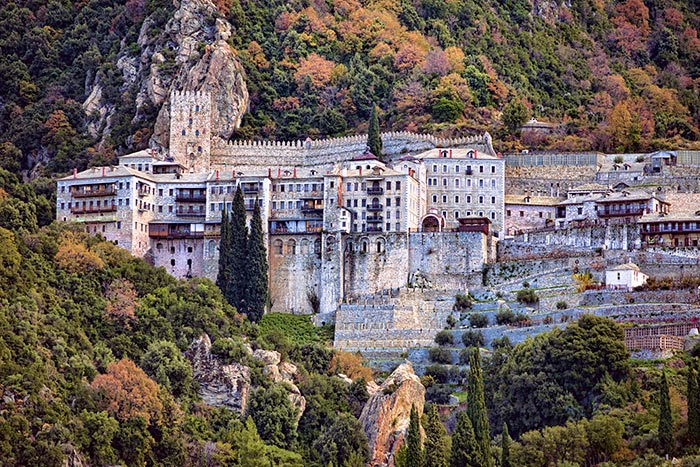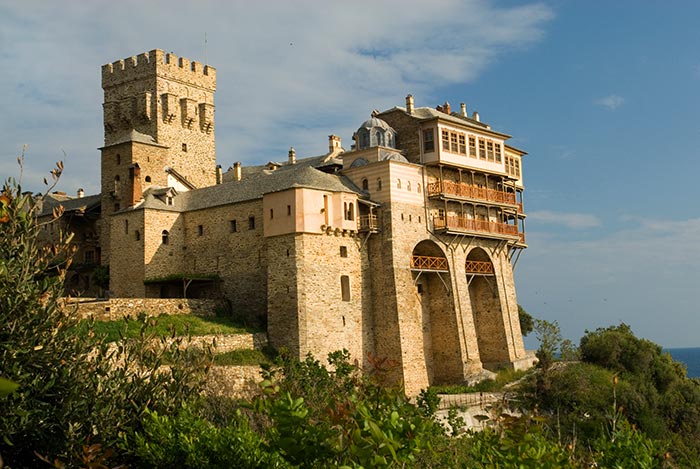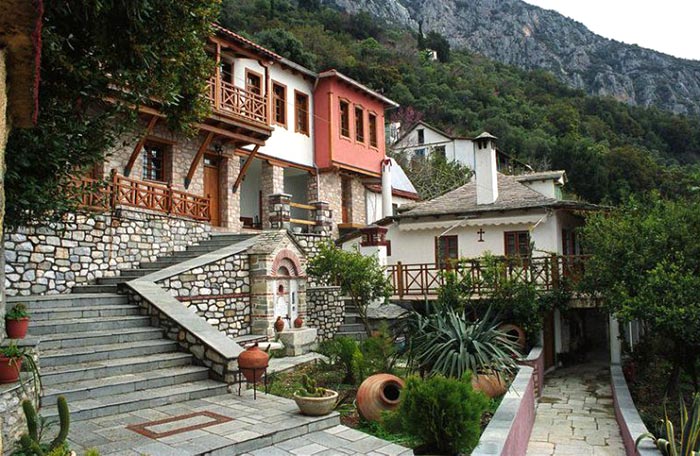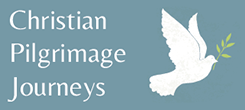
The Architecture Of Mount Athos
The architectural heritage of Mount Athos, which is the result and the remnant of the thousand-year-old activity and evolution of numerous monastic establishments, can be considered to be the summary, to a certain degree, of the medieval and more recent architecture of the Orthodox Balkan area, often illuminating it with rare examples of buildings which, for various reasons, have not survived in other areas outside the Holy Mount.
This heritage consists of numerous types of buildings (ranging from churches and fortresses to buildings with workshops and workers' houses) characterized by a great variety of architectural forms and constructional technology.
Monastery
The first monks arriving to the Holy Mount were living in caves and hollows in the rocks. Through time as monasteries were founded they were built as fortresses with high walls some in difficult to reach areas, some on the waterfront. Behind the protective walls the main church Katholikon is located in the center, the most beautiful and important building of the monastery.
In spacious yard there many chapels, Trapeza (the place monks take their meals) and Archontariki, which is the entry room of the guestrooms of the monastery.

In the yard also is located the Fiali (fountain) where the ceremony of blessing the waters takes place. In the same yard are the Kordes (the quarters of monks). Most of the monasteries have their guestrooms inside the walls, as well as the number of buildings used for the everyday life: kitchen, bakery, wine cellar, room where all oil is kept, hospital, nursing house, sacristy with all the treasures of the monastery, library and sinodiko (administration office). The walls of the fortress are completed with towers, there is a bell tower and fortified, decorated entrance to the monastery.
Outside of the walls there are quarters of the workers, laymen, who do different duties in the monastery and different workshops. There are also warehouses, arranged kiosks for the monks to have some past time, fountains, garden, and cemetery. There are organized places with washing machines, stable, oil mill, wheat mill and blacksmith’s workshop. By the sea there are fisher houses for monks or laymen fishing for the monastery and organized harbor, Arsanas, where the responsible monk would keep the boat of the monastery and where the boats from mainland would come.

In the main port of Mount Athos, Dafni and Karyes, the capital of the peninsula there are different shops where monks sell religious souvenirs and different incense used for the Holy Liturgy. There are also located inns and tavernas.
The main material used for the construction in Mount Athos is stone. The other materials used are lime with mixture of stray and goat hair and wood. The numerous woodwork, window frames, doors, etc. are made from the local wood of boundless forests of peninsula. The roofs of the building are slabs of slate, extracted from a small quarry, tiles and from the end of 19th century sheets of zinc. Most buildings are decorated with reliefs and beautiful woodwork.
Kelia
Those of the monks wishing to live away from community live, would build Kelia (monastic house) in isolated areas of the peninsula. The most of Kelia are built in the way that living quarters of the monks are joined with the chapel, there are few where two are built as one. The monks of kelia are two or three with an elder being their Spiritual Father. The chapel is simple cross-shaped with small dome and stone plated roof.
The house itself is usually a one stored building, the cellar being used for storage and oven usually is based there. If Kelia is located by the water, then cellar is used for keeping the fish boat. Wooden steps with a hatch door lead to the Archontariki, kitchen, dining-room and rooms of the monks with fire place in each.
There is also a small workshop where monks create different handcraft and items of religious art. From the side of the house with the most beautiful view and little wind there is a balcony where monks can resign and contemplate.

From old times monks of kelia would grow vegetables, keep tiny vineyards and go fishing. From the end of 17th century handcraft became one of the means of occupation in Mount Athos. Many monks sell their handcraft outside of Mount Athos, thus being able provide themselves and to facilitate and decorate their Kelia.
Restoration and conservation works, co-funded by the European Union, are performed by the Hellenic State (10th Ephorate of Byzantine Antiquities and Centre for the Preservation of the Athonite Heritage). There is on-going collaboration between the responsible services of the Ministry of Education and Religious Affairs, Culture and Sports; the General Secretariat of Culture; and other Ministries with the monastic community.
However, it should be stressed that the scheduling and execution of all work concerning individual Holy Monasteries requires their consent as well as that of the Holy Community. Mount Athos was added in the list of World Heritage UNESCO Sites in Greece in 1988.


